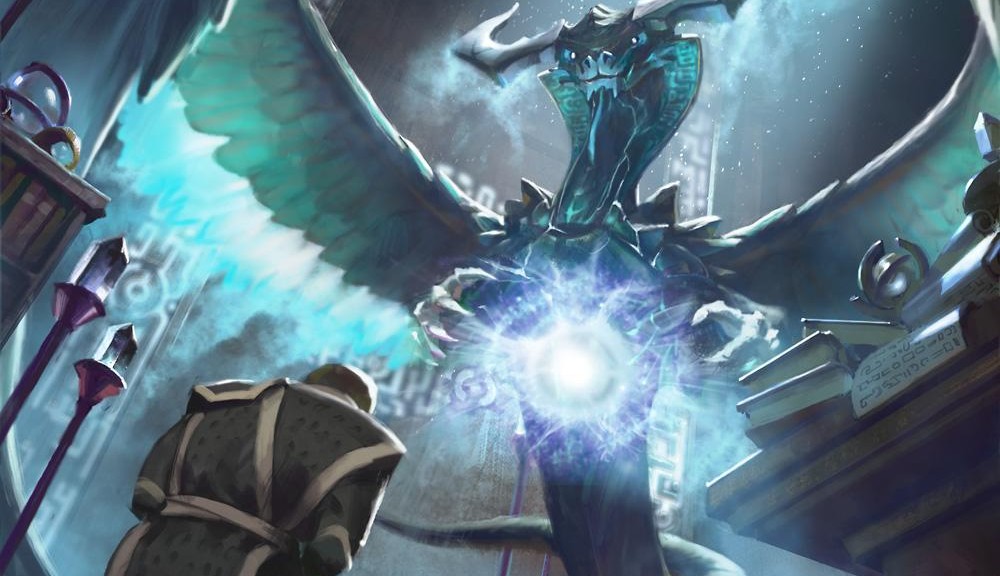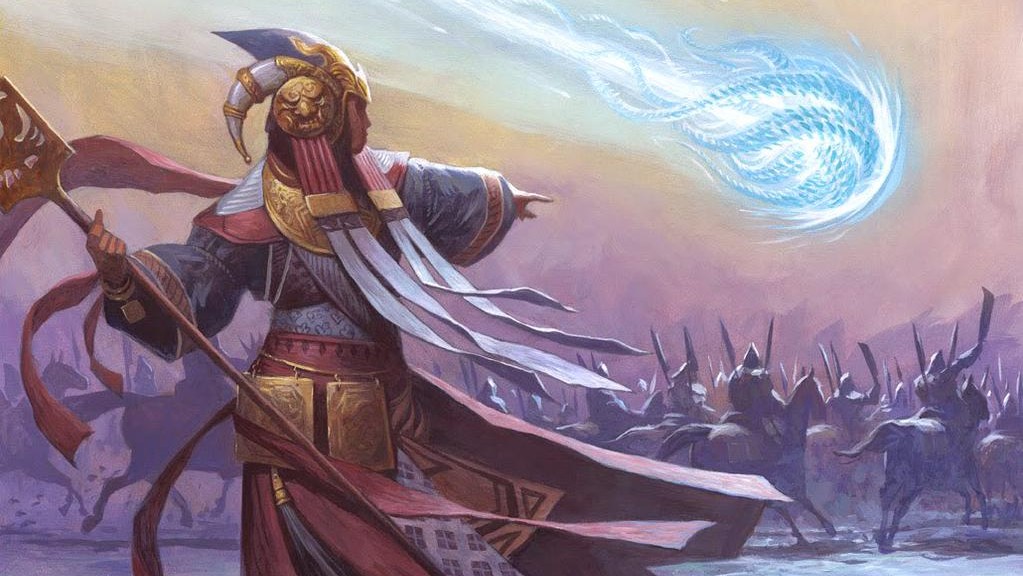By: Travis Allen
What’s old is new again.
Let’s begin by looking at some statistics to get a feel for the metagame at large.
Top 8:
3 Abzan Midrange
2 Burn
2 UR Twin
1 Amulet Bloom
18+ Point (6-4 or better) Modern Decks
30 Abzan Midrange 26%
17 Burn 15%
15 Infect 13%
8 Affinity 7%
6 UR Twin 5%
5 Amulet Bloom 4%
4 Scapeshift 3.5%
4 GR Tron 3.5%
So that I don’t have to repeat myself over and over, keep in mind the following blocks are NOT eligible for reprint in Modern Masters 2: Innistrad, Return to Ravnica, Theros, Khans of Tarkir.
The Results Are In
It doesn’t come as a surprise to many that Abzan, aka Nu-Jund, was the most important archetype of the event, even if it didn’t actually take home a trophy. When it constitutes a quarter of the room on Saturday and nearly half of the top eight, plenty of excellent Magic players recognized that it has a very high power level. That’s not surprising either, considering it gets to play some of the strongest cards in the format.
Most of the Abzan lists were very similar. Liliana of the Veil, Tarmogoyf, Abrupt Decay, Tasigur, Siege Rhino, and Lingering Souls make up the core of the deck. Sprinkle Scavenging Ooze, discard, maybe a few more removal spells. Shake well and serve tepid at a lifeless soiree where half the attendees are on so many prescription drugs they are incapable of experiencing emotion.
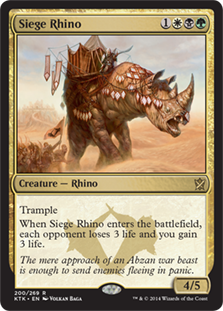
Tarmogoyf is completely saturated in value at this point. I can’t find copies at less than $190, and even then there aren’t many below $200. If any card is going to be reprinted in Modern Masters 2, it’s Tarmogoyf. Stay well away here. Liliana is also quite pricey, having risen to $80, with a floor of $85-$90 just a day or two ahead of the PT. With the Regional PTQ reprint already well-known, it seems unlikely that she’ll make another appearance this year. We know that she was originally in the file for M15 and was pulled for power level reasons. Wizards was looking for a reprint venue, and I’m assuming the promo is what they landed on. Assuming that’s true, we probably don’t see her again this year.
Abrupt Decay is likely the best bet from this deck. Copies are still floating in the $10-$12 region, which I find hard to believe is the correct price for the premier removal spell in both relevant eternal formats. Tiny Leaders growing in popularity recently also bodes very well for a card that will destroy any non-land card in the format. Looking back at Maelstrom Pulse it doesn’t look like it ever got much more expensive than $15, but I can’t find data all the way back to Alara. Other than that, I can’t think of any piece of removal that’s ever consistently sat at $20. No other piece of removal has ever been so prominent though, especially one with no other printing. I’d assume $15 is the cheapest real price for this card, and numbers pushing $25 wouldn’t surprise me in the least. The only thing that scares me here is a reprint somewhere. I’m not saying it will show up in Standard, but Wizards has a way of sneaking cards into places you wouldn’t have guessed it. Tectonic Edge showing up in the recent Commander product, for instance. I don’t fault anyone for stockpiling Abrupt Decays right now, just be aware that Wizards is also aware of how real this card is.
Lingering Souls has been printed four times. (Three of those reprints after I bought eighty or ninety copies.) Without even more reprints this will eventually hit $2, but we’re a ways away from that.
Siege Rhino and Tasigur are jumping into Modern with both feet, but the supply on these guys is still growing. They also feel exactly like the type of card Wizards knew ahead of time would be popular and wants to make available – how many supplementary products has Courser of Kruphix shown up in at this point? Two? The laws of supply and demand should keep the prices on these two suppressed for at least a little while longer. Revisiting them will be our goal around MM2/MTG:Origins. At that point drafting will have dried up, people’s attention will be elsewhere, and we’ll be entering the seasonal lull.
Expanding our perspective to some other G/W/B decks, we see some other hot numbers. Wilt-Leaf Liege is $30 now. Unsurprising as it’s from one of the least-printed Modern-border sets in Magic, and it’s exactly the type of card aspiring players want to use so they can “get” all those jerks playing Liliana of the Veil. A price tag this high is only possible because of the extremely low quantity available. One reprint will crash the value here.
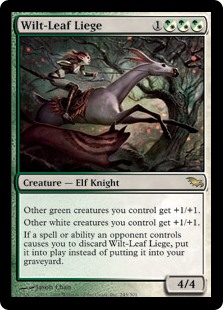
Alongside Wilt-Leaf we saw a lot of Voice of Resurgence and Gavony Township. Voice’s future in Modern was tenuous in the eyes of many, with Pod finally having been shown the door after long overstaying its welcome. This weekend the little elemental that could proved that he (she? it?) has what it takes. Prices are hanging around $15, and as we get further from Dragon’s Maze, I wouldn’t be surprised to see this break $20, especially with Twin being as popular as it was. Gavony Township also came out in force, and strikes me as having a real future. John Stern’s Friday feature match showcased just how silly the card is in concert with mana dorks and Lingering Souls tokens, two types of cards that are never going out of style. As a rare from Innistrad it’s got a fair bit of supply, so I don’t think we see it rush towards $10, but it could easily be $5 by year’s end. Take a look at the four pages of 18+ point decks – there were a lot of Townships.
Burn made up the next most popular archetype in day two, a fact that makes only Lee Sharpe and other libertarian sociopaths happy. In fact, the first Modern feature match of the Pro Tour was a burn mirror, with commentary by Rashad. This is the Magic coverage equivalent of burying the lede.
Side note: I can’t fathom why Wizards keeps putting Rashad in the booth. Every single Pro Tour, without fail, my feed is filled with people pleading to have him removed from coverage. I understand that he started GGS Live, and I respect that. He seems like a very pleasant individual and I’m sure he’s a great guy to be friends with. The problem is that he is just in over his head at these events. When compared to the commentating of even the mediocre Randy Buehler, Rashad is clearly outclassed. Given that Wizards tends to listen to their playerbase, all I can imagine at this point is that he’s got a contract.
The most exciting card in burn (and I use the word exciting very, very liberally) is Eidolon of the Great Revel. Vexing Devil is over $9 and that’s entirely on casual demand. I’d imagine Eidolon has comparable casual demand, and is also the second best red card in both Modern and Legacy to boot. Follow that up with the fact that he’s from Journey to Nyx and you’ve got a real winner on your hands. Goblin Guide, the other premier red burn spell in eternal formats, is a good $20, and would possibly be higher if people weren’t expecting a MM2 reprint. I see Eidolon breaking $10, perhaps even in this year, and $20 by the end of 2016 is on the table without a reprint. Beyond Eidolon, little in these decks is exciting, whether from the perspective of a player or investor.
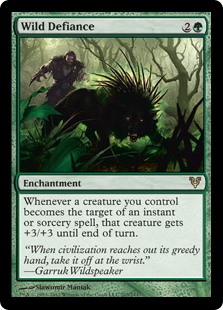
Infect, like burn, is a pile of barely-playable commons and a handful of rares. Wild Defiance isn’t played in enough numbers to move the ticker more than a dollar or two, and isn’t even necessarily the best choice for the deck. I’m staying away. What I do like from this deck is Inkmoth Nexus. It was in an event deck, but it’s still only got a single printing. Infect has been growing in Legacy at the hands of Tom Ross, and with this many copies in Modern, it may have cemented itself as a solid tier 1.5 contender. Given how hard infect is to put in Standard, I’d say this is safe for at least several months. With so much of the deck relatively inexpensive, all the value will be shoved into the few rares that round out the package. Noble Hierarch is saturated and also slated for MM2, and the rest of the manabase is old news. Inkmoth Nexus is the card best positioned to gain on Infect’s success. It could technically appear in MM2, but I doubt it. Putting in Inkmoth means including Infect as a draft strategy. I’m guessing Wizards doesn’t want to go down that path quite yet.
Affinity had a rather poor showing, likely due in part to the soup de jour midrange deck now having access to white, and subsequently Stony Silence, a stone-cold killer of weird metal hats. With Metalcraft confirmed for MM2, I’m staying the hell away from this entire deck, with the sole exception of Inkmoth Nexus.
As the winner of the whole shebang one would assume UR Twin is well positioned to pick up some value dollars, but like half of Abzan and most of Affinity, everything is pretty well saturated at this point. I’m a bit surprised Splinter Twin is “only” about $17, but that may be due to expectations of a MM2 reprint. Most appealing in the deck is Snapcaster Mage. He’s crept up towards $35 after a fall to nearly $25 a few months ago, and I expect that trend to continue. Without a reprint this year, which I wouldn’t count on, I suspect he’ll be $50 by year’s end.
What was clearly the breakout deck of the event, Amulet Bloom, garnered a remarkably odd reaction from the market given both the success and screen time it got. Amulet still hasn’t managed to crack $8, and Hive Mind is still under $4. Both of those are solid gains, but if you had asked me last week to predict the price of each if the deck took second at the Pro Tour, I would have told you they’d be much more expensive than they are. Are we finally seeing the Magic community at large start to wisen up? Is it because the deck is so damned tricky to pilot that Gerry T called it the most difficult deck he’d ever played? I’m not sure. It’s also possible that sometime within the next week people decide that those prices are just too low and they end up bought out. It did happen with Azusa after all, who is now nearly $50 a copy on TCG. This isn’t too surprising given the exceptionally low supply available, combined with her utility in both EDH and TL. Prime Titan picked up two bucks or so, but has otherwise similarly reacted with restraint. If the titans don’t show up in MM2 I like him as a trade target. $20 each isn’t hard to imagine.

Worth considering is the possibility that some component of this deck gets banned. While I don’t believe it’s possible to win on turn one, you can end the turn with your opponent at something like four life while you have multiple karoo lands and a titan in play. Turn two wins are possible and turn three wins are reasonably common without disruption. Considering Wizards wants this to be a turn four format, I’d say the deck is pretty heartily in violation of a major rule of the format. Technically Wizards does let decks capable of faster wins exist – Goryo’s Vengenace can turn one you and is still legal, and Storm and go off on turn three – but it has to be infrequent and inconsistent, even without disruption from the opponent. With no disruption from the other side of the table, Bloom can fire on turn three somewhere in the neighborhood of 20%-50% of the time I’d guess. I’m not entirely sure what they’d ban if they did hit something, but my best guess is Summer Bloom itself. Everything else in the deck is capable of doing something else interesting, and Azusa is far more fragile than Bloom, while the card Summer Bloom is essentially just a combo piece at this point. Its also miserable to watch go off, as Cohen’s multiple ten-minute turns were proof of. I’m not sure it’s too fast, or too powerful, or takes too long of turns, but it does seem to hit on all three metrics that Wizards is not a fan of.
I don’t know. Maybe they do hit it, maybe they don’t. I know the deck will be under the microscope now more than ever after that performance.
While we’re on the topic of Amulet Bloom, I’m compelled to mention that you should 100% be shipping any Leyline of Sanctities, a card often found in the sideboard of combo decks. Sanctity is the card I least want to have to own a playset of, but am forced to if I want to play filthy combo decks. Both Sanctity and Fulminator Mage have absolutely no business being as expensive as they are, and are easily reprintable in many places.
Where does all of this leave us?
Well…I’m selling. Nearly everything. Tarmogoyfs, Lilianas, Affinity staples, Twin pieces, Vendilion Clique, Wilt-Leaf Lieges, Gavony Townships. There’s a few reasons.
The first reason is the most obvious one: Modern Masters 2. We have no clue what’s in it other than Emrakul, Etched Champion, and some Metalcraft cards. Popular opinion is that Tarmogoyf will reappear, and quite possibly Dark Confidant and Vendilion Clique as well. Beyond those three big targets, there’s still piles and piles of Modern staples that are viable such as Goblin Guide, Bloodghast, Arcbound Ravager, and more. You don’t need to remind me that the first Modern Masters run ended up pushing prices up on several key cards, such as Tarmogoyf and Cryptic Command. With a stated print run four times greater than the first MM though, I’m not sure that’s going to happen this time around.
My second, more general reason for wanting to shift so many cards is that beyond MM2, there are reprint haymakers everywhere. For instance, I had about fifty or sixty Tectonic Edges I had piled up from purchasing collections, and was planning to out them this month. Then they showed up in the Commander decks this past fall, which I never expected. Oh, whoops. There goes $300 in profits. Courser of Kruphix showed up in two supplementary products, as did Hero’s Downfall. Between Event Decks, Clash Packs, and Commander precons, there’s always something around the corner waiting to bite your specs in the ass. I’m particularly concerned about two-color cards later this year. A few paragraphs back I was talking about Wilt-Leaf Liege and Gavony Township. Township in particular looks so good as a spec, but consider the last few years of Commander decks. First there was wedges, then shards, then mono-color. We’re set up for two-color Commander precons this year, and Gavony Township and Wilt-Leaf would fit very well into the GW one. Those thirty or fifty or one hundred Townships you had picked up for between $1 and $3, expecting them to hit $5 to $6? Not if they’re in an EDH precon buddy.
This may sound odd with MM2 on the horizon, but another reason I’m looking to move a lot of product and avoiding buying into any cards from this Pro Tour is because I expect that we’re at peak Modern excitement right now. Remember last year when Scalding Tarns hit $100 ahead of a Modern GP that was right before the start of the Modern PTQ season? I held on, expecting the PTQ season to push the fetches and many other Modern staples even higher. Rather than keep climbing, they crashed, and Tarns are just $60 now. More and more, it seems like Modern is a format not driven by competitive seasons or waves of interest, but rather single events that stir everyone into a frenzy, and then interest crashes afterwards. Yeah we’ll hit MM2 in a few months and that will get people talking about the format, especially with three Modern GPs immediately following MM2’s release, but then what? Nothing to really drive demand again until next February at the following Modern Pro Tour. Remember, there’s only one of those a year now. The average player might get to a single Modern GP this year. Beyond that, where is he or she going to play? There’s no Modern PTQ season, and something like 87% of North American PreTQs are Standard. Even if WotC takes the reins on that, most players are only going to have local store events and maybe one or two SCGs to play much Modern.
Tie this concern that we’re at the peak of Modern’s excitement right now into the fact that January and February tend to be the highest tide for Magic cards in general, and you can see that we’re probably in the 95th percentile of any given card’s price for the year on over 90% of the Modern index.
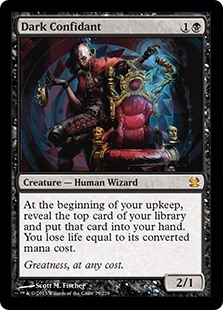
I’m not foolish enough to ignore the fact that some cards will still manage to climb. Liliana is reasonably well positioned, and I wouldn’t be surprised at all to see her crest $100 or more during the MM2 hype. Snapcaster is similarly well-positioned. Those are only possibilities though – neither is guaranteed. What if Liliana falls to $60 between now and June, and the MM2 spike only brings her back up to $75? Without a doubt, there will be Modern cards that gain value throughout the year and make people money. Those cards will be the minority though, and most will be lower in three months or six months than they are now. If your portfolio is diverse, the answer here is to move most of your product, take your profits, and look for greener pastures. Yes, you may miss on $120 Lilianas or $90 Scalding Tarns. But you’ll hit on $30 Wilt-Leafs, and $70 Confidants, and $200 Goyfs, and $70 Cliques, and plenty of other cards that will collectively lose a lot more money than the few cards that gain in price.
I’m not selling everything. I’m holding onto my Snapcasters, as that’s safe enough that I consider it worth the risk. I’ve still got a bunch of Goryo’s Vengeances and Through the Breaches, and lots of Scars fastlands. Perhaps against my better judgment, Vengevines remain stashed. I’ve got a bunch of other stuff under $10 that I’m holding onto as well because their prices haven’t yet risen enough to be worth selling, and if they get reprinted I don’t stand to lose that much on each. After a quick count, the number of Modern-legal cards in my spec box worth at least $10 that I’m holding onto is five, and there are probably more than fifty or sixty unique cards in there.
A point of clarification: all the prior advice is through the lens of investing, in one capacity or another. If you’re looking to play Kibler’s GWb deck, don’t hesitate to pick up the Wilt-Leaf Lieges. If you want to play Affinity, trade for Arcbound Ravagers. You shouldn’t feel bad about grabbing a playset of anything you actually want to play with, save perhaps Tarmogoyf. This is a game first and a trading platform second. If you want to play with certain cards, buy the cards. If your only goal is to make money, why are you here and not in the stock market?
Springjack Pasture
I’ve told you that I don’t like holding onto anything worth double digits and that I’m looking for greener pastures. Exactly what are those cards?
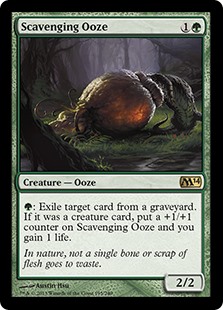
Scavenging Ooze: Relatively low print run, even with the Steam promo. Was all over the place this weekend in Abzan decks, and anything that makes green mana is likely to want some number of copies. At $5 or so a copy, this could be an easy double up.
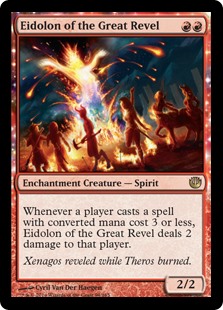
Eidolon of the Great Revel: Way underpriced for how good this card and burn in general are in Modern and Legacy. I’m slightly worried it shows up in a clash pack or something, but even then I’m not sure it will be enough to stunt growth. After I move some of the pricier things I’ve still got kicking around, I may drop some cash on these guys.
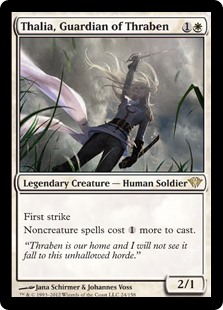
Thalia, Guardian of Thraben: I said last week it feels underpriced, and I still feel that way.

Khans Fetches: Most of these are at or near their lifetime floors. I’m trading for these all day long. They’re the closest thing we have in Magic to currency other than, well, currency. As for purchasing…
Foil Khans Fetches: Return to Ravnica shocks were (universally?) the cheapest they were within a few months of release. Make no bones about it, the buy-in here is damn expensive. The upside is that all of them could gain 15%-50% of value within a year, all with basically no fears of loss in price.
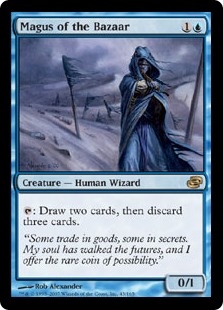
Crazy Specs: This topic was broached recently. The short version is that if you miss, you don’t lose much, and if you hit, it more than makes up for your misses. Take for example Faith’s Reward, of which I currently have around 100 copies. I paid $.25 each, for a total of $25. If it completely tanks and is reprinted eight times, they’re still worth $.10 each and I lose $15. If it hits it big and they reach $8, I just made enough to cover having missed on other specs several times over. You can’t do this with just any card – you have to find ones that are in low supply with high power level. It’s not for everyone, but when you hit, you hit hard. Another one I’ve picked up a lot of? Magus of the Bazaar.
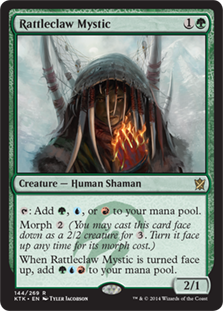
Rattleclaw Mystic: Buy-a-Boxes rarely miss. When Theros rotates we lose Sylvan Caryatid, Voyaging Satyr, and Elvish Mystic.
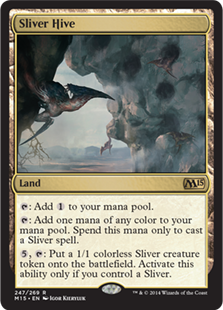
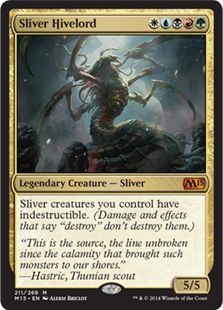
Sliver Hive(lord): Guaranteed risers that are reasonably safe from reprints, and cheap to boot.
Modern has become far too financially volatile a format for me to want to have any large investment in right now. With a major reprint outlet a few months away and very little else driving players at the local level to become emotionally and financially invested in Modern, I’ll sit out for a bit. It feels sort of odd since it’s been such a large percentage of my investment strategy for the past two years, but for now it’s time to leave it be. Maybe this August after all the MM2 price swings settle down I’ll revisit it.
I’ve no doubt plenty of people will disagree with my strategy and calls here, but I don’t mind. When people are talking about how they slam dunked Abrupt Decay or Liliana it will be easy to feel like I sold out early. What’s important to remember is that we see the highlight reel when people hit home runs, but we won’t be hearing from the guys who lost hundreds of dollars after going deep on Gavony Township when it’s printed in Commander decks later this year. Rather than chase cards with big price tags and big targets on their head, I’m going to avoid being greedy and instead go after cards with low risk profiles that are less sexy.
Except for Magus of the Bazaar. That’s sexy.
